|
Pivotal Pro Football Moments
pivotal NFL postseason moment: A decision by a coach or an action by a player that establishes or changes the momentum of a playoff game.
1967: The Ice Bowl
NFL Championship Game: Dallas Cowboys @ Green Bay Packers
Cowboys E Frank Clarke couldn't believe it when he answered his wake-up call Sunday morning and heard the operator say it was 13 degrees below zero in Green Bay WI. "Thirteen degrees below zero? Ow, God. We weren't prepared for that, so it was demoralizing."
Dallas DT Bob Lilly recalled: "We had our meetings.. We were in great spirits. We were finally relatively healthy. The Packers were beat up pretty bad. We hadn't had a great year, but we had become better and better as the year went on. ... We all knew a cold front was coming, but it wasn't supposed to get there until after the game, sometime the next night. So we weren't concerned about that."
Dallas coach Tom Landry told reporters Saturday, "I don't expect the cold to bother us. All I want is a good field to play on." But he based his comment on the mid-30s predictions for Sunday's game.
Packers General Manager/Coach Vince Lombardi had spent $80,000 the previous spring to install a General Electric heating system that consisted of 14 miles of heating coils under the field. If ever the new device were needed, this was the day. Yet the head groundskeeper Chuck Lane learned from his assistants after they removed the tarp that the field was frozen. Telling that to Lombardi would be like "telling him that his wife had been unfaithful ..." But he did so anyway and was met with disbelief. The system had been tested Saturday and functioned fine when the two teams had worked out. But apparently the coil system had malfunctioned in the extreme conditions.
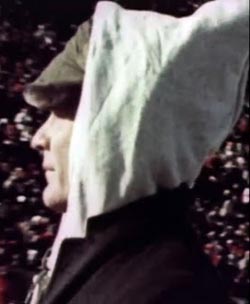 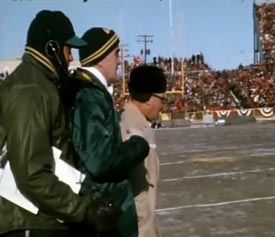 L-R: Brave Ice BowlFans; Coach Tom Landry, not as nattily attired as usual; Icy patches on field visible in this picture of Vince Lombardi and Packer coaches In the Packers locker room, a trainer passed out long underwear to everyone, including the coaches. Lombardi had OKed wearing it but didn't want players to put on too much clothing to the point that they couldn't move freely. Several players requested gloves, but Vince vetoed the idea except for linemen who would not handle the ball.
During warmups, players from both sides kept their hands tucked in their pants. Breathing actually hurt, burning the throat and lungs. Even the guys from the Big Ten and other northern schools had never played in conditions like these. Players likened the field to a stucco wall turned on its side or, in some spots, a glass surface.
The officials' whistles froze quickly after the kickoff forcing them to rely on hand signals. They tried again after halftime, but line judge Bill Schliebaum had his whistle freeze to his lips and lost a layer of skin yanking it loose.
Packers Take the Lead
For the first quarter and a half, it appeared the Cowboys had capitulated to the elements and simply wanted to go home.
As could be expected, the Packers adapted to the elements quicker than the visitors. The home team drove for a touchdown on its first possession. After receiving a punt on the 18, QB Bart Starr directed an efficient 16-play drive. He threw six passes, called eight running plays, and was helped by two penalties on the Cowboys, one for interference, the other for holding. WR Boyd Dowler caught the 8y touchdown pass. 7-0 Packers
Starr struck again in the second quarter. Facing third-and-one on the Dallas 43, Bart did what the opponent should have expected him to do on third-and-short – go for broke. He faked to FB Ben Wilson, then fired a perfect pass to Dowler breaking past S Ray Renfro into the end zone. 14-0 Packers
Dallas Scoop and Score
Down 14-0 under extreme duress from the conditions, the Cowboys needed a break. They got it with four minutes left to halftime.
The Packers had first-and-10 on their own 26. Starr dropped back to pass, but the Doomsday Front Four broke through, causing him to retreat away from Bob Lilly into the arms of DE Willie Townes. His bare hands numb, Bart dropped the ball, which George Andrie scooped up and carried into the end zone.
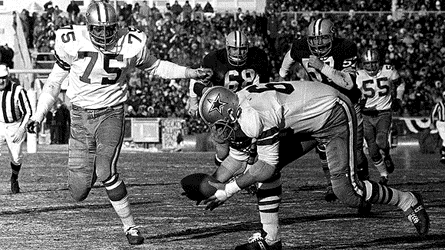 George Andrie picks up Starr's fumble. Years later, Andrie recalled his fumble return touchdown: "I never thought I would get into the end zone. I would run a couple of steps, slip, slide, and finally fell in. It was unreal. But at that point, it gave us a lift, and I was pretty elated about it."
As it would turn out, Green Bay would not regain the momentum until it was almost too late.
Dallas Gets Another Break
One of Lombardi's gloveless ball-handlers gave Dallas still another gift before halftime. S Willie Wood, who had fumbled a punt only once in eight seasons–and that in a driving rain–watched Danny Villanueva's punt fade away from him. Willie signaled for a fair catch but muffed it. Frank Clarke pounced on the pigskin at the 17.
After failing to gain a first, the Cowboys called on Danny Villanueva for a 21y field goal to trail only 14-10 heading to the locker room despite the fact that they had managed only three first downs–none in the second quarter–and only 42y for the half.
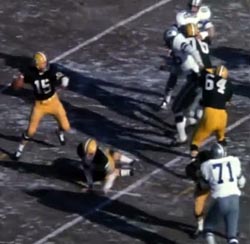 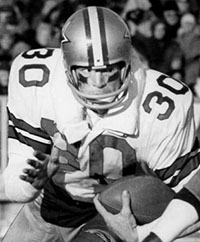 Starr passes in first quarter. Although neither team scored in the third period, the Cowboys' momentum carried over from the last few minutes of the first half. The Doomsday Defense held the Packers to a mere 10y in the period. On its first possession of the half, Dallas marched to the 13 where LB Lee Roy Caffey caused QB Don Meredith to fumble to end the threat. The Cowboys threw Starr for a 16y loss and got the ball back in good field position after the punt. But that drive ended on a missed field goal from the 47.
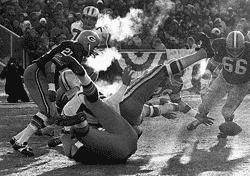 L: Meredith fumbles in the third quarter. R: Lance Rentzel heads for the end zone. Dallas Takes the Lead
As the final period began, Dallas had second-and-five at the 50 after a short punt. HB Dan Reeves told Meredith in the huddle, "Don, these guys force hard on the run. Let's try fire pitch." Dan, who played quarterback at South Carolina, had executed the play successfully several times during the season. Meredith handed to Reeves, who started a left end sweep. Meanwhile, Lance Rentzel angled across from his flanker position as if to block FS Willie Wood. Noticing that CB Bob Jeter had moved up to stop the run, Reeves cocked his arm and threw downfield. Dan heard Jeter curse loudly as he threw. Knowing he had been suckered, Bob could only watch as Rentzel caught the ball behind S Tom Brown and ran untouched into the end zone. After the PAT, Dallas led 17-14.
The tables had turned completely. Now Green Bay's prospects seemed as bleak as those of the visitors midway through the second quarter. Between Dowler's second touchdown and Reeves' touchdown pass, the Cowboys had held the Packers' offense to -18y in 23 plays. Packers G Jerry Kramer admitted thinking, "Well, maybe this is the year we don't make it, that it all ends."
On their next two possessions, the Packers gained only 21y, 14 coming on an interference penalty. Don Chandler's field goal try from the 40 missed badly.
Dallas picked up two first downs to run off five minutes before punting to the GB 31 with 4:50 left. Starr led his troops onto the field for what might be their last chance.
The last ten times the Packers had the ball, the most they gained on any possession was 14y. Before trotting out, Bart talked to Lombardi. Vince cautioned against anything fancy. "Just try to keep moving the ball."
Noticing that the Dallas linebackers, Howley and Edwards, were dropping back to help on pass coverage, Donny Anderson, Paul Hornung's replacement at halfback, told his quarterback: "If you dump me the ball, I can get eight or 10y every play." This advice reinforced what Starr had heard at halftime. According to the Packers, everyone was calm in the huddle, especially the Field General. "We're going in," he said.
What transpired was arguably the finest clutch drive in NFL history.
Do or Die Drive
Starr starts with a short pass to Anderson for six after faking it to the halfback. Then Mercein angles at right end for seven and a first down. Starr hits Dowler for 13. First-and-ten at the Dallas 43. Then a setback as Townes throws Anderson for a 9y loss on a sweep.
Starr, finding no one open downfield, lobs to Anderson for 12 and hits him again for nine. Donny does an excellent job of keeping his footing as he picks his way through defenders. 2nd-and-19 has become 1st-and-10 at the 31. Two minutes left.
With Anderson attracting attention, Mercein tells Starr he's open on the left. As Starr drops to pass, he sees Dowler and Anderson covered but, as promised, Mercein is available. So Bart floats the ball to his fullback who catches it while backpedaling, then runs past the linebacker and cornerback before careening out on the 11 to stop the clock.
Mercein on telling Starr he was open: "I'd never done that before, but I knew I was open in the flat, and I knew that the linebacker (Dave Edwards) was taking kind of a steep drop back. So sure enough, I said to Bart, 'If you need me, I'll be open over on the left after I check for a blitz pickup.' That was your first responsibility as a back, to check for the blitz. If they didn't come, you go out on a pattern. So when Edwards dropped straight back again, I just did a little flare, and Bart laid it out there. I was so open I think he kind of pulled the string on it a little bit, that the ball actually kind of drifted to my outside shoulder instead of catching it on my inside shoulder, which would have been easier. So I had to turn a little bit and snatched it with my hands, which is what I tried to do all the time. I've got pretty big hands and can catch the football. It wasn't a problem catch, but it looked a little more difficult."
"Sucker" Play
For years to come, Starr will consider the next play his best call of the game: GIVE 54 or the "sucker play" (although Lombardi didn't like the word "sucker"). During the week, Vince told his quarterback to pick a good spot to use it. The formation and start of the play shout sweep, with LG Gale Gillingham pulling to influence All-Pro T Bob Lilly to move laterally. LT Bob Skoronski has to block George Andrie, whom Starr expected to try to cover the area Lilly had left. Starr fakes the pitch but hands to Mercein, who bursts through the hole Lilly vacated to the three.
Starr: "We decided to use Lilly's tremendous quickness and anticipation to our advantage. We pulled our guard, Gale Gillingham, to the right, hoping that Lilly would try to beat him to the point of attack. This would take Lilly out of the play, which was going to be run in the spot where he originally lined up. This was a risky call, but I believed the time had come to try it, as the adrenaline was running full tilt, and Lilly would likely try to make a decisive play for their defense, which he had done so many times."
Lilly: "I recognized the sucker play, but I couldn't get back. It was a play we normally could have made easily, but I slid down, and George slid down."
Anderson dives ahead for first-and-goal less than a yard from the goal line. If instant replay had been available, he might have been given a touchdown, which would have obviated the drama to come. The Packers call their second timeout of the half with 0:20 remaining.
Anderson tries the middle again but slips as he takes the handoff, losing his momentum. No gain. Starr uses his final timeout with 16 seconds left.
"Run it!"
Starr jogs to the sideline for one of the most famous coach-quarterback dialogs in football history. Neither suggests kicking a field goal. After nine years, Starr thinks like his coach, which is why Vince gives his quarterback so much latitude. Starr wants to go with a wedge play, the running back knifing between center and guard. But he needs RG Jerry Kramer to get good footing to drive Jethro Pugh backward. The Packers have noticed from films that Pugh stands high in his down position, making him the easiest defender to cut down.
Starr remembers Anderson's slip on the earlier play. He tells Lombardi there was nothing wrong with the plays the Packers had run. It's just that the backs couldn't get their footing. So he suggests, "Why don't I just keep it?"
"Run it, and let's get the hell out of here," yells Lombardi, just as frozen as everyone else. After Starr returns to the huddle, Director of Player Personnel Pat Peppler walks over to Lombardi and asks what Starr will call. "Damned if I know," snaps Vince.
Starr recalled, "All he said, which was so typical for this man, was, 'Run it! And let's get the hell out of here!' I'm going back to the huddle at this brutally cold time, and I'm actually laughing."
On the field, Mercein is "100% positive" his number will be called for an old-fashioned dive play. Years later, Coach Landry recalled: "We thought they would throw. We thought they probably would go to an option, a rollout run or pass so they could stop the clock [with an incompletion] if it didn't work."
The stage is set for one of the most historic plays in NFL history.
In the huddle, Kramer assures Starr he can get good footing. So Bart calls "Brown right, 31 wedge." Brown right is the formation, 3 means the fullback, and 1 means the hole between center and right guard. Even though the Packers have no quarterback sneak in their playbook to audible to, Starr has decided he will follow Kramer himself.
On the sideline, Wood and Willie Davis can't bear to watch. Out of timeouts, Lombardi wonders if there'll be enough time to run the field goal unit on if the play fails. As the Packers break the huddle, the fans come to life and start to cheer.
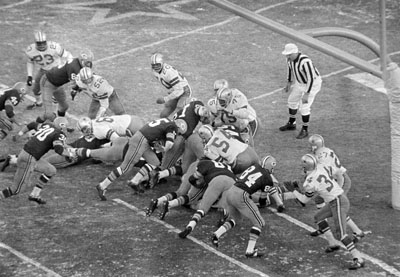 Starr sneaks over behind Kramer and Bowman. Kramer gets off the snap so quickly some think he was offside. With Bowman's help, he cuts Pugh down and back as ordered. Mercein starts forward expecting the ball only to see Bart drive into the end zone. As Chuck falls onto the pile, he throws his hands up to make sure the officials don't call him for aiding the ball carrier. Spectators interpret his gesture as the touchdown signal.
As Tex Maule wrote in his Sports Illustrated article: "Suddenly, for 50,000 people, spring came."
Don Chandler's PAT kick made the final score Green Bay 21 Dallas 17.
Dan Reeves, as coach of the Broncos years later, said: "I still don't think it was a smart play. But maybe that's the reason Lombardi won all those championship, and I haven't won any."
Mercein: "Bad is only bad if it doesn't work. To me, success justifies a lot of questionable calls." Of course, a questionable call can still produce a successful play if an offensive lineman beats the snap count. Films show that a split second before the ball was centered, Kramer picked up his right hand and started moving forward. Since the Cowboys never watched the game films, they didn't discover that secret. So Jethro Pugh kept to himself his memory of the play. "In a goal-line situation like that, you key the football. And I could visualize Kramer's hand moving an instant before the ball did. My first thought [after the play] was, 'We got 'em. He's offsides, and that'll cost 'em five yards.' I was shocked when I didn't see a flag. I kept looking around for one. Years later, The Guy Who Got Blocked On Starr's Sneak finally got a chance to view the game films. "I saw it, and I said, 'My goodness, I was right.'" Kramer was coy about his alleged edge. In his 1968 best seller Instant Replay, he wrote: "I wouldn't swear that I didn't beat the center's snap by a fraction of a second. I wouldn't swear that I wasn't actually offside on the play." The block made Kramer famous, which led to his book. Few acknowledged the contribution of the man next to him, C Ken Bowman. His role was to stay low and clog the middle to keep MLB Lee Roy Jordan from making the tackle. Kramer's job was to lift Pugh up so Bowman could get a low shot at him. Together, the two drove Pugh out of the hole. Bowman is upset that Kramer got all the attention. "The older I get, the more it bothers me. I was young and stupid, and he [Kramer] patted me on the shoulder as he went up to the [television] podium after the game and said, 'Let an old man have his moment in the spotlight. You've got 10, 12 more years.' What I didn't realize was that blocks like that come along once in .... hell, it's been two decades now." Pugh: "Kramer had good position, but Bowman did more of the blocking. ... I saw Kramer several months after his book came out and had become a big seller and asked him if he had any plans to give me a percentage since I had helped make him a star." |